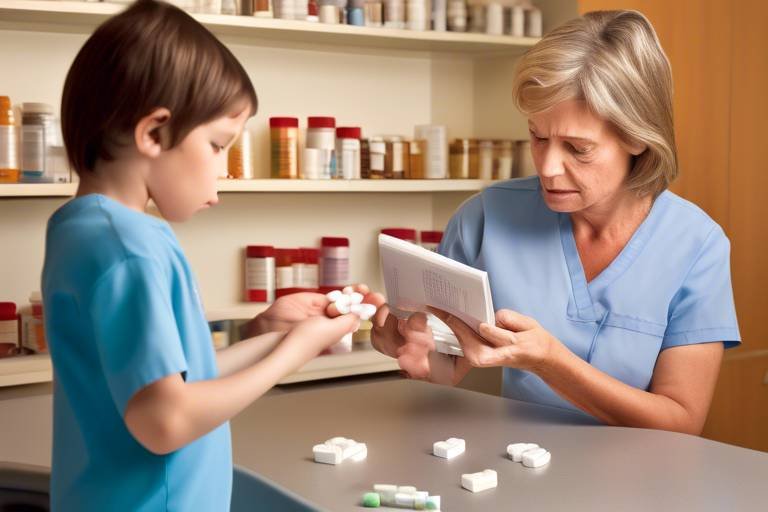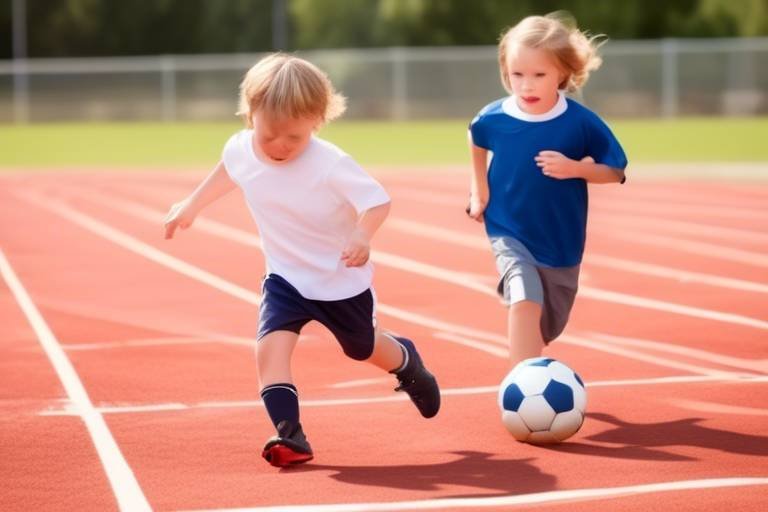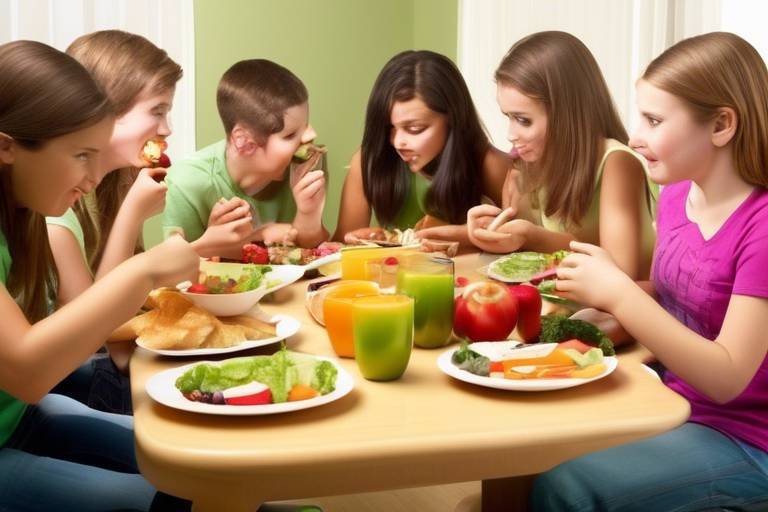Encouraging Independence: Teaching Kids to Care for Their Health
In today's fast-paced world, teaching children to care for their own health is more important than ever. As parents and educators, we have the remarkable opportunity to guide young minds towards independence in health management. Imagine a future where children confidently choose nutritious foods, engage in physical activities, and practice self-care without constant reminders. This article dives into the significance of fostering independence in health among kids, offering practical strategies and insights that empower them to make healthy choices.
Understanding why health independence is crucial for children can help parents and educators cultivate a sense of responsibility and self-care in young individuals. When children learn to make their own health choices, they develop a stronger sense of autonomy and confidence. This independence not only prepares them for adulthood but also instills a lifelong appreciation for wellness. Think of it as planting a seed; with the right nurturing, it can grow into a robust tree of health that bears fruit throughout their lives.
Establishing healthy routines at a young age lays the foundation for lifelong wellness. Children are like sponges, soaking up information and habits from their surroundings. By introducing them to healthy practices early on, we set them up for success. For instance, incorporating a variety of fruits and vegetables into their meals can help them develop a taste for nutritious foods. Additionally, creating a structured routine that includes physical activity can make exercise a natural part of their day. After all, wouldn’t it be great if kids viewed healthy living as an exciting adventure rather than a chore?
Teaching children about nutrition empowers them to make informed food choices. This education can be both fun and engaging. For younger children, you can use colorful charts that illustrate food groups, while older kids might appreciate discussions about the importance of vitamins and minerals. The goal is to make nutrition relatable and interesting. For example, you could explain how certain foods can help them run faster or think better in school. By making these connections, children can see the real-world benefits of healthy eating.
Engaging kids in cooking can enhance their understanding of nutrition while making it enjoyable. Cooking together can be a delightful bonding experience that teaches children valuable skills. Try setting up a mini cooking class at home where kids can help prepare simple, healthy recipes. For instance, making a colorful fruit salad can teach them about different fruits and their benefits. You could even turn it into a friendly competition: who can create the most vibrant dish? This not only makes cooking fun but also helps them take ownership of their food choices.
Involving children in grocery shopping can teach them about food selection and budgeting. When you take them along, explain how to read labels and choose fresh produce. You can create a fun scavenger hunt where they have to find specific healthy items on your list. This interactive approach not only makes shopping more enjoyable but also gives them practical skills that they will use in the future. Plus, it opens up conversations about why certain foods are better for them than others, reinforcing their understanding of nutrition.
Encouraging regular physical activity is vital for children's health. It's essential to find ways to motivate kids to stay active without making it feel like a chore. Consider introducing them to a variety of activities, from team sports to dance classes or even outdoor adventures like hiking or biking. The key is to let them explore different options until they find something they truly enjoy. After all, when physical activity is fun, it becomes a natural part of their lifestyle. Wouldn’t it be wonderful if kids looked forward to exercise as much as they do to playtime?
Teaching self-care is essential for promoting independence. Self-care goes beyond physical health; it encompasses emotional well-being and personal hygiene. By instilling these practices early, children learn to prioritize their health and happiness. Encourage them to express their feelings and manage stress through activities like journaling or art. This holistic approach to self-care helps children become well-rounded individuals who understand the importance of caring for both their bodies and their minds.
Instilling good hygiene habits in children is crucial for their health. Teaching them the importance of washing hands, brushing teeth, and bathing regularly not only keeps them healthy but also fosters a sense of responsibility. You might create a fun song or rhyme to help them remember their hygiene routine. Making it enjoyable can turn a mundane task into a delightful habit. Plus, when children take pride in their cleanliness, it boosts their self-esteem and confidence.
Supporting children's emotional health is just as important as physical health. It's vital to create an environment where kids feel safe to express their feelings and seek help when needed. Encourage open conversations about emotions, and teach them coping strategies for when they're feeling overwhelmed. Activities like mindfulness exercises or simple breathing techniques can be beneficial. By equipping them with these tools, we help children build emotional resilience, preparing them to face life's challenges with confidence.
- What age should I start teaching my child about nutrition?
It's never too early! Start introducing basic concepts around age 3, and gradually build on that knowledge as they grow. - How can I make physical activity fun for my child?
Incorporate games, sports, or family outings that include movement. The key is to find activities they enjoy! - What are some simple self-care practices for kids?
Encourage regular hygiene routines, mindfulness activities, and open discussions about feelings to promote emotional health.

The Importance of Health Independence
Understanding why health independence is crucial for children can help parents and educators cultivate a sense of responsibility and self-care in young individuals. When children learn to take charge of their health, they develop essential life skills that not only benefit them now but also set the stage for a healthier future. Imagine a child who knows how to choose nutritious snacks, engage in physical activity, and manage their emotions effectively—this is the power of health independence!
Health independence fosters a sense of ownership over one’s body and well-being. When children are taught to make informed decisions regarding their health, they become more aware of the consequences of their choices. This awareness can lead to healthier eating habits, regular exercise, and improved mental health. Just like learning to ride a bike, gaining health independence can be a bit wobbly at first, but with practice and encouragement, children can ride confidently into a healthier lifestyle.
Moreover, instilling health independence in children can significantly reduce their reliance on parents and caregivers for everyday health decisions. This shift not only empowers children but also alleviates some of the pressures on parents. Instead of constantly monitoring every meal or activity, parents can take a step back, knowing their children are equipped to make wise choices. It's like teaching a child to swim; once they learn, they can enjoy the water without fear, and parents can relax on the sidelines.
In addition, health independence is linked to improved self-esteem and confidence. When children successfully make healthy choices, they feel a sense of accomplishment. This positive reinforcement encourages them to continue making healthy decisions. To illustrate this, consider the following benefits of fostering health independence:
- Responsibility: Children learn to take responsibility for their own health.
- Confidence: Making independent choices boosts self-esteem.
- Critical Thinking: Kids develop problem-solving skills by evaluating their options.
- Long-term Health: Establishing healthy habits early leads to a lifetime of wellness.
Ultimately, teaching children about health independence is not just about making choices; it's about equipping them with the tools they need to navigate the complexities of health as they grow. By fostering an environment where children can explore, learn, and make decisions about their health, we are not only preparing them for the future but also instilling values that will last a lifetime. So, let's get started on this journey of empowerment and independence!

Building Healthy Habits Early
Establishing healthy routines early in a child's life is like planting seeds in a garden; with the right care and nurturing, those seeds can blossom into lifelong habits. When children learn to prioritize their health from a young age, they are more likely to carry those values into adulthood. But how do we ensure that these habits take root? The key lies in creating an engaging environment that encourages exploration and learning.
One effective strategy is to introduce healthy eating practices through fun and interactive experiences. For instance, involving kids in meal preparation not only teaches them about nutrition but also allows them to experiment with different flavors and ingredients. When children have a hand in cooking, they are more likely to be excited about trying new foods. Imagine a child proudly presenting a colorful salad they made themselves! This sense of accomplishment can ignite a passion for healthy eating.
Another fantastic way to promote healthy habits is through physical activity. Kids have boundless energy, so why not channel that energy into fun physical activities? Organizing family outings that involve hiking, biking, or even dancing can create positive associations with exercise. Instead of viewing physical activity as a chore, children can learn to see it as an exciting opportunity for fun and connection. Remember, the goal is to make these activities enjoyable, so they become a natural part of their routine.
Additionally, teaching children about hydration is crucial. Water is often overlooked, yet it plays a vital role in maintaining health. Encourage kids to drink water regularly, especially during playtime or after school. You can even make it a game by tracking their water intake and celebrating milestones. This not only reinforces the importance of hydration but also makes it a fun challenge!
To wrap it all up, building healthy habits early is about creating a supportive and engaging environment where children can learn and grow. By intertwining education with fun activities, we can help them develop a positive relationship with their health that lasts a lifetime. So, let’s not just tell them what to do; let’s show them how to enjoy the journey of being healthy!
- Why is it important to teach kids about healthy eating?
Teaching kids about healthy eating empowers them to make informed choices, fostering independence and responsibility towards their health. - How can I make physical activity fun for my child?
Incorporate games, family activities, and outdoor adventures to make physical activity enjoyable rather than a chore. - What are some easy healthy snacks for kids?
Fruits, yogurt, veggie sticks with hummus, and whole-grain crackers are all excellent choices that are nutritious and appealing to kids.

Nutrition Education
Teaching children about nutrition is like giving them a treasure map to a healthier life. When kids understand what goes into their bodies, they're empowered to make informed food choices that can lead to a lifetime of healthy habits. But how do we make this complex subject accessible and fun for our little ones? It starts with simplifying the information and making it engaging.
First and foremost, it's essential to introduce the basic food groups. You can explain how different foods fuel our bodies in various ways. For instance, fruits and vegetables provide vitamins and minerals that help us grow strong, while proteins help build our muscles. A simple way to visualize this is by using a colorful plate model. You can create a table like the one below to illustrate the food groups:
| Food Group | Examples | Benefits |
|---|---|---|
| Fruits | Apples, Bananas, Berries | Rich in vitamins and antioxidants |
| Vegetables | Carrots, Spinach, Broccoli | High in fiber and essential nutrients |
| Proteins | Chicken, Beans, Eggs | Builds and repairs tissues |
| Grains | Rice, Bread, Oats | Provides energy and fiber |
| Dairy | Milk, Yogurt, Cheese | Good source of calcium and protein |
Next, you can turn nutrition education into a fun game. For example, have your kids create their own food diary, where they can track what they eat throughout the week. This not only helps them become more aware of their choices but also encourages them to try new foods. You can even add a twist by introducing a reward system for trying new fruits or vegetables. It’s like a mini adventure every time they sit down for a meal!
Another engaging way to teach kids about nutrition is through interactive cooking sessions. When children participate in preparing their meals, they gain hands-on experience with food. You can explain the nutritional benefits of each ingredient as you cook together. For instance, while making a smoothie, you can discuss how spinach is packed with iron and how bananas provide energy. This method not only makes learning enjoyable but also instills a sense of accomplishment in them.
Lastly, don’t forget about the importance of moderation. Teaching children that it’s okay to enjoy treats in moderation is crucial. Use the concept of a balanced diet to explain that all foods can fit into a healthy lifestyle. You might say something like, “Think of your meals as a rainbow – the more colors, the better!” This analogy helps them visualize the variety of foods they should include in their diet.
In conclusion, nutrition education is a vital part of fostering independence in children regarding their health. By making learning about food fun and interactive, you’re not just teaching them to eat well; you’re equipping them with the knowledge they need to make healthy choices for a lifetime. Remember, the journey to healthy eating starts with small, consistent steps, and every little effort counts!

Fun Cooking Activities
Cooking with kids can be an absolute blast! It’s not just about preparing meals; it’s a golden opportunity to teach them about nutrition, teamwork, and creativity. Imagine the joy on their faces as they mix, stir, and create delicious dishes together. This hands-on experience not only makes healthy eating fun but also instills a sense of accomplishment in children. So, how can we turn the kitchen into a playground of culinary exploration? Here are some engaging activities that can transform cooking into a delightful adventure.
First off, let’s talk about theme nights. You could set up an Italian night where your little chefs can make homemade pizza from scratch. Give them the freedom to choose their toppings, and watch as they get creative! Not only does this allow them to experiment with flavors, but it also teaches them about portion control and balanced meals. Plus, who doesn’t love pizza?
Another fantastic idea is to host a “Colorful Plate Challenge”. Challenge your kids to create a meal that includes as many colors as possible. This activity not only makes the plate visually appealing but also encourages them to explore a variety of fruits and vegetables. After all, the more colors on your plate, the more nutrients you’re likely to consume! You can even turn it into a mini-competition, where everyone presents their colorful creations and votes on the most vibrant dish.
Engaging kids in cooking also means letting them take the lead. Try having a “Chef of the Week” program where each child can choose a recipe they want to prepare for the family. This gives them a sense of ownership and responsibility. They’ll learn to read recipes, measure ingredients, and even manage time in the kitchen. Plus, it’s a great way for them to share their culinary skills with the family!
Don’t forget about the fun of making snacks together. Healthy snacks can be just as exciting as full meals. Set up a DIY trail mix bar where kids can mix nuts, seeds, dried fruits, and even a sprinkle of dark chocolate. This not only allows them to make their own choices but also teaches them about healthy snacking. You can even label the ingredients with fun names to make it more engaging!
Lastly, consider incorporating food science experiments into your cooking sessions. For instance, making homemade yogurt or bread can be a fascinating way to show kids how ingredients react with one another. They’ll be amazed to see how simple ingredients can transform into something delicious. Plus, it’s a fantastic opportunity to talk about the importance of fermentation and how it contributes to gut health.
In conclusion, cooking with kids is about more than just making food; it’s about creating memories and fostering independence. By introducing fun cooking activities, you’re empowering them to make healthier choices while having a great time in the kitchen. So, roll up those sleeves, put on some aprons, and get ready for a culinary adventure that will not only nourish their bodies but also their minds!
- How can I make cooking more engaging for my kids?
Incorporate fun themes, challenges, and let them take the lead in selecting recipes! - What are some easy recipes to start with?
Pizzas, smoothies, and homemade snacks are great starting points. - Are there any safety tips I should consider?
Always supervise your children in the kitchen, especially around sharp objects and hot surfaces. - How can cooking help with my child's education?
Cooking teaches math through measuring, science through reactions, and enhances reading skills through following recipes.

Grocery Shopping Together
Grocery shopping isn't just a mundane chore; it can be a fantastic opportunity to teach children about making healthy choices and understanding the value of nutrition. Imagine walking through the aisles with your child, transforming each item into a lesson. Why not turn this weekly task into an engaging adventure? When you involve kids in grocery shopping, you’re not just filling your cart; you’re filling their minds with knowledge about food selection, budgeting, and even meal planning.
First things first, let's make it fun! Before heading out, create a simple grocery list together. This not only gives them a sense of responsibility but also helps them understand the importance of planning. As you go through the store, point out different sections—fruits, vegetables, grains, and proteins. Ask them questions, like, “What fruits do you think are in season right now?” or “Can you find a healthy snack that we can enjoy together?” This interactive approach keeps them engaged and curious.
While browsing, take the time to discuss the nutritional value of various foods. For example, when you reach the cereal aisle, explain how some cereals are packed with sugar while others are full of fiber and whole grains. This knowledge empowers them to make better choices when they’re shopping alone in the future. You might say, “Look at the labels! What do you notice about the sugar content?” This way, they start to develop critical thinking skills regarding food.
Another great aspect of grocery shopping is the budget. Teach your child about money management by giving them a small budget for their own snack choices. Let them make decisions about what to buy within that budget. This not only teaches them about financial responsibility but also about the value of making choices. They might even surprise you with their selections!
Lastly, don’t forget to celebrate your little victories. After shopping, you could say, “Great job picking out those veggies! Let’s make a colorful salad tonight.” This positive reinforcement encourages them to continue making healthy choices in the future. Remember, grocery shopping together is not just about buying food; it's about building a foundation for lifelong healthy habits.
- Why is it important to involve children in grocery shopping?
Involving children in grocery shopping teaches them about food choices, budgeting, and nutrition, fostering a sense of independence and responsibility. - What age is appropriate to start taking kids grocery shopping?
Children can start participating in grocery shopping as early as 3 years old, with simple tasks like picking out fruits or vegetables. - How can I make grocery shopping fun for my child?
Make it an adventure by turning it into a game, creating a shopping list together, and discussing the nutritional value of foods as you shop.

Physical Activity Engagement
Encouraging kids to embrace physical activity is like planting a seed; it needs the right conditions to grow into a healthy habit. In today’s digital age, where screens often dominate our children’s leisure time, finding ways to engage them in fun and active pursuits is more important than ever. But how can we inspire them to put down the remote and lace up their sneakers? It starts with making physical activity feel less like a chore and more like an adventure!
One effective way to get children excited about being active is to incorporate games into their routines. Think about it: when was the last time you saw a child turn down an invitation to play tag or ride bikes with friends? By introducing activities that feel more like play than exercise, you can capture their interest effortlessly. For instance, consider organizing family sports days or neighborhood scavenger hunts. These not only promote physical activity but also foster bonding and teamwork.
Another fantastic approach is to tap into the power of variety. Kids thrive on new experiences, so why not mix things up? Introduce them to different sports, dance classes, or even martial arts. You could create a monthly "activity calendar" that showcases a different physical activity each week. This way, they can explore their interests and discover what they truly enjoy. Plus, it keeps the excitement alive, preventing any potential boredom from setting in.
Moreover, it’s essential to lead by example. Children are like sponges; they absorb what they see. If they witness their parents or guardians engaging in regular physical activity, they’re more likely to follow suit. So, whether it’s going for a family hike, playing a game of soccer in the backyard, or simply enjoying a dance party in the living room, showing them that being active is a fun part of life can have a profound impact.
To further enhance their engagement, consider forming a community or school-based activity group. This could be a running club, a dance troupe, or even a gardening team! When children see their peers participating, it creates a sense of belonging and motivation. They’ll be more inclined to join in when they know their friends are part of the fun.
Here’s a quick table summarizing some fun ways to engage kids in physical activity:
| Activity | Description |
|---|---|
| Family Sports Day | A day filled with various sports and games, encouraging friendly competition. |
| Dance Party | Turn on some music and let loose! Dancing is a great way to stay active while having fun. |
| Neighborhood Scavenger Hunt | Create a list of items or landmarks for kids to find in the neighborhood. |
| Exploring Nature | Plan regular hikes or nature walks to get kids moving while enjoying the outdoors. |
In conclusion, engaging children in physical activity is all about creativity, enthusiasm, and making it a shared experience. When kids view physical activity as a joyful part of their lives, they’re more likely to carry those habits into adulthood. So, let’s put on our sneakers, grab a soccer ball, and show our kids just how fun being active can be!
Q: How much physical activity should children get each day?
A: Children should aim for at least 60 minutes of moderate to vigorous physical activity every day. This can include anything from playing outside to participating in organized sports.
Q: What if my child is not interested in traditional sports?
A: That’s perfectly okay! Encourage them to explore various activities like dance, martial arts, or even outdoor adventures like hiking. The key is to find something they enjoy.
Q: How can I make physical activity a family affair?
A: Plan regular family outings that involve physical activity, such as biking, hiking, or even playing games in the park. It’s a great way to bond while staying active!

Self-Care Practices
Teaching children about self-care is essential for fostering independence and promoting overall well-being. When kids learn to take care of themselves, they not only build confidence but also develop a sense of responsibility that will serve them well throughout their lives. In this fast-paced world, equipping children with self-care practices is like giving them a toolbox filled with the essentials for navigating life's challenges. So, what can we do to instill these valuable habits in our little ones?
First and foremost, let's talk about the importance of personal hygiene routines. Instilling good hygiene habits in children is crucial for their health. It’s not just about keeping them clean; it’s about teaching them the value of taking care of their bodies. Kids should understand that washing hands, brushing teeth, and bathing regularly are not just chores but acts of self-love. Imagine how empowered they will feel when they realize that these small actions can prevent illness and promote a healthy lifestyle!
To make hygiene fun, parents can create engaging activities. For instance, turning handwashing into a game by timing how long they can wash their hands while singing their favorite song can make the process enjoyable. Additionally, you could set up a personal hygiene chart that tracks their daily routines. This not only provides a visual reminder but also rewards them for consistency, reinforcing the habit.
Next, let’s dive into the realm of emotional well-being. Supporting children's emotional health is just as important as their physical health. Children often face various pressures, whether from school, friendships, or family dynamics. Teaching them how to manage their emotions is like giving them a compass to navigate the stormy seas of life. One effective way to foster emotional resilience is through open communication. Encourage your child to express their feelings and validate their emotions. This creates a safe space where they can share their thoughts without fear of judgment.
Moreover, introducing mindfulness practices can significantly enhance emotional well-being. Simple techniques such as deep breathing exercises or guided imagery can help children learn to calm their minds. For example, you could practice mindful breathing together for a few minutes each day. This practice not only helps them focus but also teaches them how to handle stress effectively. Over time, these practices can become a natural part of their daily routine, much like brushing their teeth!
Lastly, let’s not forget the significance of physical activity as a self-care practice. Encouraging regular exercise is vital for children's health, both physically and emotionally. It’s not just about hitting the gym; it’s about finding activities they enjoy. Whether it's dancing, biking, or playing a sport, when kids find joy in movement, they are more likely to stick with it. You can even turn family outings into active adventures—think hiking, swimming, or playing tag in the park. These moments not only promote fitness but also strengthen family bonds.
In summary, teaching children self-care practices is a gift that will last a lifetime. By focusing on personal hygiene, emotional well-being, and physical activity, we empower them to take charge of their health. Just like planting a seed, with the right nurturing, these practices will grow and flourish, leading to healthier, happier individuals.
- What age should I start teaching my child about self-care? It's never too early! You can begin introducing basic hygiene practices as soon as they are toddlers.
- How can I make hygiene fun for my child? Incorporate games, songs, and charts to track their progress. Make it a family activity!
- What are some mindfulness activities for kids? Simple breathing exercises, yoga, or even nature walks can be great ways to introduce mindfulness.
- How do I encourage my child to be active? Find activities they enjoy and participate with them. Make it a fun family affair!

Personal Hygiene Routines
Teaching children about personal hygiene is a fundamental part of fostering their independence and overall health. It’s not just about keeping them clean; it’s about instilling a sense of responsibility and self-respect. Imagine your child as a little superhero, equipped with the power of cleanliness to fend off germs and stay healthy. By introducing them to personal hygiene routines, you're not only protecting their physical health but also boosting their confidence and self-esteem.
To start, it's essential to make hygiene practices fun and engaging. For instance, you can create a hygiene checklist that your child can follow daily. This checklist can include activities such as brushing teeth, washing hands, and bathing. By turning these chores into a game, you can motivate them to take ownership of their hygiene. You might say, "Let’s see how quickly you can brush your teeth and still do it well!" This approach not only makes it enjoyable but also encourages them to be consistent.
Another effective strategy is to involve them in the process. For example, when teaching them how to wash their hands properly, you can turn it into a fun song or rhyme. Singing while washing hands can make the process feel less like a chore and more like a fun activity. You might even consider using a timer to encourage them to wash their hands for at least 20 seconds, turning it into a mini-challenge. This way, they learn the value of thoroughness while enjoying themselves.
Additionally, it's crucial to explain the why behind each hygiene practice. Children are naturally curious, so when they understand that washing their hands can help keep them from getting sick, they are more likely to take it seriously. You can use simple analogies, like comparing germs to tiny monsters that need to be washed away. This makes the concept relatable and easier for them to grasp.
As they grow older, you can introduce more advanced hygiene practices, such as caring for their skin and hair. Discuss the importance of using sunscreen and staying hydrated. This not only teaches them about personal care but also helps them understand the broader concept of health and wellness. You might say, "Just like we wash our hands to remove dirt, we need to protect our skin from the sun's harsh rays!"
In conclusion, instilling good personal hygiene routines in children is a vital step toward fostering their independence. By making the process fun, engaging, and educational, you empower them to take charge of their health and well-being. Remember, these habits will serve them well into adulthood, shaping them into responsible individuals who value their health.
- Why is personal hygiene important for children?
Personal hygiene is crucial as it helps prevent illnesses, boosts self-esteem, and teaches children responsibility. - At what age should I start teaching my child about hygiene?
Start introducing basic hygiene concepts as early as toddlers, gradually increasing complexity as they grow. - How can I make hygiene practices fun for my child?
Use songs, games, and challenges to engage them and turn hygiene into an enjoyable routine.

Emotional Well-being
Emotional well-being is a crucial aspect of a child's overall health, yet it often gets overshadowed by physical health concerns. As parents and caregivers, it's essential to recognize that just like our bodies, our minds need regular care and attention. Imagine emotional well-being as a garden; if we don't nurture it, it can become overgrown with weeds of anxiety, stress, and sadness. So, how can we cultivate a flourishing emotional landscape for our children?
First and foremost, open communication is key. Encourage your children to express their feelings freely. This can be as simple as asking them about their day or how they felt during a specific event. By creating a safe space for dialogue, you allow them to articulate their emotions, which is the first step in managing them. Remember, children often don’t have the vocabulary to express complex feelings, so be patient and guide them through their emotional maze.
Another effective strategy is to teach children about emotional regulation. This doesn’t mean suppressing their feelings; rather, it’s about helping them understand and cope with their emotions. Techniques such as deep breathing, mindfulness, or even physical activities like yoga can be incredibly beneficial. For instance, when a child feels overwhelmed, a simple breathing exercise can act as a reset button, helping them regain control and clarity.
Additionally, incorporating emotional literacy into daily activities can significantly enhance a child's ability to navigate their feelings. You might consider using storybooks that illustrate different emotions and scenarios. After reading, engage your child in a discussion about the characters' feelings and how they might handle similar situations. This not only builds empathy but also equips them with tools to deal with their own emotional challenges.
Moreover, don’t underestimate the power of routine. Children thrive on predictability, and having a structured daily routine provides them with a sense of security. When they know what to expect, it reduces anxiety and helps them feel more grounded. Within this routine, include time for fun and relaxation, as these are essential for emotional recovery and resilience.
Lastly, fostering social connections is vital for emotional well-being. Encourage your children to build friendships and engage in group activities, whether it’s sports, clubs, or community service. These interactions not only provide a sense of belonging but also teach them valuable social skills. Remember, just as plants need sunlight and water, children need love and friendship to thrive emotionally.
By focusing on these strategies, we can help our children develop a strong foundation for emotional health. Just like any skill, emotional well-being requires practice and patience, but the rewards are immeasurable. A child who understands their emotions is better equipped to face the world, making choices that promote both their mental and physical health.
- What are some signs that my child may be struggling with their emotional well-being?
Look for changes in behavior, such as increased irritability, withdrawal from friends, changes in sleep patterns, or a drop in academic performance. These can be indicators that your child may need support.
- How can I encourage my child to talk about their feelings?
Make it a habit to check in with them daily. Ask open-ended questions and listen without judgment. Share your own feelings to model emotional openness.
- Are there activities that can help improve my child's emotional well-being?
Yes! Activities like journaling, art, and physical exercise can greatly enhance emotional expression and management. Encourage your child to find what they enjoy.
Frequently Asked Questions
- Why is it important for children to learn about health independence?
Teaching children about health independence is crucial because it empowers them to make informed choices about their well-being. When kids understand the importance of taking care of themselves, they develop a sense of responsibility that can lead to healthier habits throughout their lives.
- What are some effective ways to introduce healthy habits to children?
Introducing healthy habits can be fun and engaging! Start by incorporating activities like cooking together, making grocery shopping an educational experience, and encouraging outdoor play. The key is to make these activities enjoyable so that kids associate health with fun.
- How can I teach my child about nutrition in an age-appropriate way?
Nutrition education can be tailored to your child's age by using simple concepts. For younger kids, use colorful visuals and fun games to explain healthy foods. For older children, involve them in meal planning and discussions about the benefits of different foods to foster deeper understanding.
- What fun cooking activities can I do with my kids?
Cooking can be a blast! Try making homemade pizzas where kids can choose their toppings, or create colorful fruit salads. You can also have a "mystery ingredient" challenge where kids must use a specific healthy ingredient in a dish. These activities not only teach cooking skills but also nutrition!
- How can grocery shopping be a learning experience for children?
Grocery shopping can be a fantastic educational outing! Involve your kids by letting them help create a shopping list, comparing prices, and choosing healthy options. Discuss the nutritional value of items as you shop, turning an ordinary chore into a valuable learning experience.
- What are some ways to encourage physical activity in kids?
Encouraging physical activity can be as simple as making it a family affair! Organize weekend hikes, bike rides, or even backyard games. You can also enroll your kids in sports or dance classes that spark their interest, making exercise feel more like play than a chore.
- Why are self-care practices important for children?
Self-care practices are vital for children as they help build independence and resilience. Teaching kids how to manage their hygiene, emotions, and daily routines instills a sense of control over their lives, which is essential for their overall well-being.
- How can I instill good hygiene habits in my child?
Instilling good hygiene habits can start with simple daily routines. Encourage regular hand washing, brushing teeth, and bathing by making these activities part of a fun schedule. Use songs or games to make hygiene practices enjoyable and memorable!
- What strategies can I use to support my child's emotional well-being?
Supporting emotional well-being involves open communication and creating a safe space for your child to express their feelings. Encourage them to talk about their day, practice mindfulness techniques, and engage in activities that promote relaxation and joy, like art or music.



















